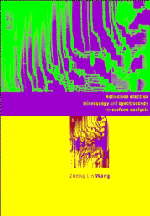Book contents
- Frontmatter
- Contents
- Preface
- Symbols and definitions
- 0 Introduction
- 1 Kinematical electron diffraction
- Part A Diffraction of reflected electrons
- Part B Imaging of reflected electrons
- 5 Imaging surfaces in TEM
- 6 Contrast mechanisms of reflected electron imaging
- 7 Applications of UHV REM
- 8 Applications of non-UHV REM
- Part C Inelastic scattering and spectrometry of reflected electrons
- Appendix A Physical constants, electron wavelengths and wave numbers
- Appendix B The crystal inner potential and electron scattering factor
- Appendix C.1 Crystallographic structure systems
- Appendix C.2 A FORTRAN program for calculating crystallographic data
- Appendix D Electron diffraction patterns of several types of crystal structures
- Appendix E.1 A FORTRAN program for single-loss spectra of a thin crystal slab in TEM
- Appendix E.2 A FORTRAN program for single-loss REELS spectra in RHEED
- Appendix E.3 A FORTRAN program for single-loss spectra of parallel-to-surface incident beams
- Appendix E.4 A FORTRAN program for single-loss spectra of interface excitation in TEM
- Appendix F A bibliography of REM, SREM and REELS
- References
- Materials index
- Subject index
6 - Contrast mechanisms of reflected electron imaging
Published online by Cambridge University Press: 18 January 2010
- Frontmatter
- Contents
- Preface
- Symbols and definitions
- 0 Introduction
- 1 Kinematical electron diffraction
- Part A Diffraction of reflected electrons
- Part B Imaging of reflected electrons
- 5 Imaging surfaces in TEM
- 6 Contrast mechanisms of reflected electron imaging
- 7 Applications of UHV REM
- 8 Applications of non-UHV REM
- Part C Inelastic scattering and spectrometry of reflected electrons
- Appendix A Physical constants, electron wavelengths and wave numbers
- Appendix B The crystal inner potential and electron scattering factor
- Appendix C.1 Crystallographic structure systems
- Appendix C.2 A FORTRAN program for calculating crystallographic data
- Appendix D Electron diffraction patterns of several types of crystal structures
- Appendix E.1 A FORTRAN program for single-loss spectra of a thin crystal slab in TEM
- Appendix E.2 A FORTRAN program for single-loss REELS spectra in RHEED
- Appendix E.3 A FORTRAN program for single-loss spectra of parallel-to-surface incident beams
- Appendix E.4 A FORTRAN program for single-loss spectra of interface excitation in TEM
- Appendix F A bibliography of REM, SREM and REELS
- References
- Materials index
- Subject index
Summary
Image calculations for REM are usually difficult because it is necessary to incorporate surface defects, such as steps and dislocations. This, in principle, can be done with the PeTSM theory; but, in practice, the huge amount of computation required and the sensitivity of REM image contrast to focus, beam convergence and diffracting conditions make the calculations rather involved and difficult compared with experimental observations. Attempts have been made to simulate surface step images (Peng and Cowley, 1986; Ma and Marks, 1990), but the results are still not very satisfactory. For this reason, in this chapter, the contrast mechanisms of REM imaging are described based on simplified models, in order to illustrate the physical concepts.
There are four basic contrast mechanisms in REM. Phase contrast (or Fresnel contrast) is produced by the path-length difference (or phase shift) of electron waves due to the change in surface morphology. This contrast dominates the images of atom-high surface steps. High-resolution information can be obtained from the phase contrast mechanism. Diffraction contrast (or Bragg contrast) is produced by the variation of local Bragg reflection angles due to lattice distortion from dislocations, local strain and crystal boundaries. Compositional contrast is produced by a variation in scattering power of different elements. This type of contrast appears on different surface domains or regions, depending on the local composition, and usually has relatively lower resolution. Finally, geometrical (or morphology) contrast is produced by variation in surface geometry, such as large surface steps and facets.
- Type
- Chapter
- Information
- Publisher: Cambridge University PressPrint publication year: 1996

